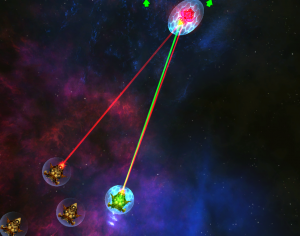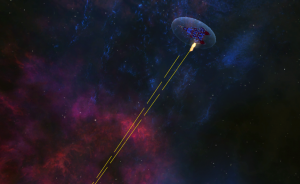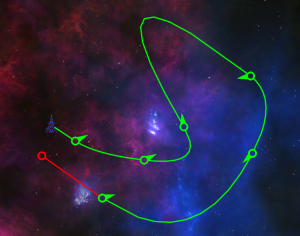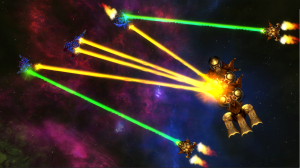This is something I noticed and started worrying about a little bit, then a couple of playtesters mentioned it, so now it’s something I worry about a lot. The tone of the narrative and the tone of the gameplay don’t match.
On the one hand is the narrative, based in a universe where space battles are fought over petty slights such as a game getting an 8/10 instead of a 10/10 or a disagreement on which episode of an anime is the best. The humor was a bit dark, but it was still meant to be mostly light hearted, not too serious and, hopefully, funny.
On the other hand are the battles. Space ships flying around throwing lasers, missiles and bullets at each other. It’s a deep and complicated game, I’m pretty used to it, but repeated play tests demonstrate that it’s not something you just pick up and play. All of this creates a very serious tone. Which is kind of at odds with the light hearted tone of the narrative.
I thought about trying to make the combat lighter, primarily by changing the weapons, missiles left behind a multicolored smoke trail, lasers came in rainbow colors, etc. It didn’t seem to do much for me, not enough that I bothered showing it to anyone. Additionally making the weapons goofy looking wasn’t going to do anything about the heavy tactical weight the whole thing carries. I don’t know that there’s anything I can do to balance the heaviness created by the complexity of the gameplay.
Another thing is that it seems like it’s going to take a lot more writing to really convey a humorous universe like the one I’m imagining. It’s fairly different, sure everyone is familiar with the internet, but a universe where death is temporary so murder isn’t a big deal, where planets fill in for internet communities, etc. etc. It’s going to really require a good deal of world building, and right now, to be honest, I’m trying to cut out as much of that as I can. I’m trying to focus entirely on the combat, which I should have been doing anyway for the last two years. And that means I want everything else to be as simple as possible. I think of Steam Birds, which plays similar to Flame Warrior, just a lot less complicated, and in it they have a very short description for each level. They tap into our inherent understanding of World War I/II to quickly give context to the battles. Each of their mission descriptions would probably fit in a tweet. And right now that sounds pretty blasted good. Plus, the humorous approach I was trying seems to go against the natural context that people assume when they engage in the gameplay. Space battles naturally bring to mind sci-fi stories that tend to not be goofy.
And that brings me to the biggest objection to making the combat goofier is the game was primarily inspired by the Honor Harrington book series. It’s a sci-fi series all about space combat and political intrigue. It has it’s funny moments, but for the most part it’s very serious. Other inspirations included Star Wars, Battlestar Galactica, really any sci-fi property that included space battles. And the thing about all of those is that on the whole they are fairly serious. They all inform the fantasy of controlling giant space battleships going to war. The thing that really drives me to make games is to try to capture the feel of something to deliver a gameplay system that allows the player to act out a fantasy that isn’t delivered in the same way elsewhere. And it’s going to be pretty difficult to feel like Commander Adama fighting an epic space battle if you’re shooting missiles that look like Nyan-Cat.
So that brings me to a decision. Do I stick with the original humorous context, trying to convey the feel of the world through brief mission introductions. Or do I abandon that and go for the more serious theme that the gameplay seems to naturally suggest. I tried looking at other games and other media that are funny to see what they do. First off, I think the only goofy space game I’m aware of is Space Zombies and Pirates, which I honestly didn’t play a lot of. It seemed to convey it’s humor primarily through text. There’s an anime called Irresponsible Captain Tylor that is all about humor and space battles, but the thing is, that all of the humor happens inside the ship. It’s not all that funny that the ships are shooting at each other, what’s funny is that Tylor is hiding under his chair or trying to surrender or whatever, and circumstances always work out to his favor, making everyone think he’s a tactical genius. I don’t exactly have the means to cut to the insides of ships and show their captain and crews bumbling about. Hitchiker’s Guide to the Galaxy does a similar thing, they have the occasional space battle, and they are funny because the computer is tied up making tea, or something similar. Games that do make the combat humorous depend largely on strange weapons and enemies. Like Plants vs Zombies, the zombies are goofy looking and the plants all have faces and look kind of funny. That would suggest that if I want to stick with humor I should redesign the graphics, a task which I just don’t have the resources for.
My final hope to keep the humor would be to make it a little more dark, something along the lines of the Fallout series. It was grim, but also funny at times. But even in those games the combat is really funny, it’s the little things you find along the way, the little world building moments that I am trying to throw out to get this thing to market sooner. Plus, I think it would take a really deft hand to make the dark humor work, something that I’m not really sure I have the skill for.
To tell the truth, as I’ve been writing this blog post I’m feeling like the answer is obvious, ditch the humor and go with the serious tone of the combat, not grim-dark, but definitely not goofy. The combat is where 98% of the game takes place, and fighting against the tone of the combat is going to take a lot of energy. So I think there’s only one question that remains: do I stick with the name? I’ve felt like Flame Warrior was maybe a bit generic, and the only justification I had for it was the fact that the game revolved around the petty feuds that go on in internet forums. If I’m taking a more serious approach then the name is a real stretch. On the one hand, my game is still incredibly obscure, and a name change probably isn’t going to do much damage to my name recognition, it’s not like I’ve been featured on any big gaming web sites. On the other hand, I would be throwing out what little name recognition I do have, which may honestly be my most precious resource. I know that I’ve seen a couple of high profile AAA games change their names late in development, so it’s certainly not unprecedented, but it’s still something that requires some thought.







